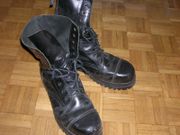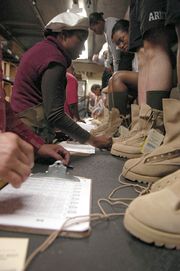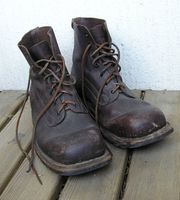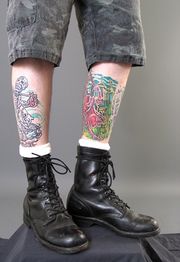Combat boot
Combat boots are military boots designed to be worn by soldiers during actual combat or combat training as opposed to during parades and other ceremonial duties. Modern combat boots are designed to provide a combination of grip, ankle stability, and foot protection suitable to a rugged environment. They are traditionally made of hardened, and sometimes waterproofed leather. Today, many combat boots incorporate many technologies originating in civilian hiking boots, such as Gore-Tex nylon side panels, which improve ventilation and comfort.[1] They are also often specialized for certain climates and conditions, such as jungle boots, desert boots, and cold weather boots as well as specific uses, such as tanker boots and jump boots.[1][2][3]
Contents |
History

Early
The first soldiers to have been issued boots were the foot soldiers of the Roman legions, who wore hobnail boots called caligae to war.
During the English Civil War each soldier of the New Model Army was issued three shoes or ankle boots. After every march the soldier would change them round to ensure they received even wear. Following the Restoration shoes and uniforms followed the civilian pattern: shoes with buckles were used by most armies from 1660 until around 1800. Hessian boots were used by cavalry from the 18th century until World War I.
Late in the Napoleonic Wars the British army began to be issued lace-up boots that replaced the older buckle shoes. These "Blucher" boots remained in use throughout the 19th century and were used in conflicts that included the Crimean War, Zulu War and Boer War. By World War I, they had been replaced with the Galosh pattern or "George" boots. These in turn were replaced by ammunition boots which were used from World War II until the 1950s.
Rifle units of the US military were equipped with calf-high boots in the War of 1812.[4] From the 1820s until before the Civil War soldiers were issued ankle-high boots which were made on straight lasts. There was no "left" or "right" boot: instead they shaped themselves to the wearer's feet over time. Needless to say, until they were broken in, these boots were very uncomfortable and often resulted in blisters. These were replaced in 1858 with an improved version used until the 1880s, known as Jeff Davis boots after Jefferson Davis the secretary of war who re-equipped the army in the 1850s.
Trench boots
The 1917 Trench Boot was an adaptation of the boots American manufacturers were selling to the French and Belgian armies at the beginning of World War I. In American service, it replaced the Russet Marching Shoe. The boot was made of tanned cowhide with a half middle sole covered by a full sole. Iron plates were fixed to the heel. It was a great improvement, however it lacked waterproofing.
It soon evolved into the 1918 Trench Boot, also called the Pershing Boot after General John Pershing, who oversaw its creation. It used heavier leather in its construction, and had several minor changes from the 1917 Boot.
US Army Boots, Combat Service
The first true modern combat boots in the US Army, officially called the "Boots, Combat Service," were introduced in conjunction with the M-1943 Uniform Ensemble during World War II.[5][6] They were modified service shoes, with an extended, rough-out or, more commonly, a smooth leather high-top cuff added.[5] The cuff was closed using two buckles, allowing the boots to replace the existing service shoes and leggings worn by most soldiers with a more convenient and practical solution.[5] The boots, and the service shoes they were made from, had a one piece sole and heel, made from molded synthetic or reclaimed rubber.[5][6][7] These "double buckle" boots were worn through the Korean War as a substitute for the Boots, Russet, Leather Lace Up introduced in 1948. The first type of Combat Boots, or Combat Tropical boots were based on the "buckle boot" design and worn during the early parts of the Vietnam War.[8]

Shined combat boots
In 1957, the US Army switched to shined black combat boots, although the transition to black boots was not completed until late in the Vietnam War, which also saw the introduction of the jungle boot.[3][8][9] Both of these boots had a direct molded sole.[10] The jungle boot had a black leather lower and an olive drab nylon upper.[11] Black boots continued to be worn following Vietnam, with the M81 BDU, although non-shine boots were considered by the Army.[3][12][13][14][15] As the BDU was replaced with the MCCUU, Army Combat Uniform, and Airman Battle Uniform the services transitioned to more practical, non-shine footwear.[3][16][17]

Current American combat boots
As the United States Marine Corps transitioned from its utility uniform to the MCCUU, they discarded shined black combat boots, and switched to more functional tan rough-out (non-shine) combat boots, with either hot weather or temperate weather versions. The standard-issue boot is the Belleville 500 Waterproof USMC combat boot. Commercial versions of this boot are authorized without limitation other than they must be at least 8 inches in height and bear the Eagle, Globe, and Anchor on the outer heel of each boot.
The United States Army followed suit in 2002 with the introduction of the Army Combat Uniform, which also switched to tan rough-out combat boots, called the Army Combat Boot, and moisture wicking socks.[1][3] Commercial versions of this boot are authorized without limitation other than they must be at least 8 inches in height and are no longer authorized to have a 'shoe-like' appearance.[18] Two versions exist, a 2.5 lb temperate weather boot, and a 2 lb hot weather (desert) boot.[1] Current manufacturers are Altama, Bates, Belleville Shoe, McRae, Rocky and Wellco.[1][19]
The US Air Force uses a foliage green suede combat boot with its Airman Battle Uniform, although a tan version is authorized until 2011, when the green boot will become mandatory.[20]
Current United Kingdom combat boots
In 2006, the British Army elected to replace both the "combat assault boots" that were in general service and the desert boots issued for operations. They conducted trials in Iraq, Afghanistan and Cyprus during autumn of 2007, and are now issuing new boots made by Meindl and Lowa (including boots specially designed for women's feet) for operational purposes.[21] [22] British soldiers still use the CAB for combat training and general service although privately purchased boots are often deemed acceptable as long as they are made of black leather. The Guards Regiments in the Household Division still use modified Ammunition boots. The Boots being primarily made of leather can be brought to a high shine for the ceremonial purpose, although the boots used as every-day military footwear, tend to be left comparatively dull, but clean.
Current Australian Combat Boots
Since 2000, the Australian Army (As well as other its other Defence branches), primarily uses the Redback Terra Combat Boot as a replacement of the Vietnam War-era General Purpose combat boots. It was given a limited amount of tests in 1999, and was later distributed in 2000. Despite the boot's general aptitude for the tasks which the ADF had first put it in place for, it still had major flaws. 90% of all negative feedback from soldiers was about its inappropriate sizing, having only 43 different sizes. Many also claimed that its sole could rot in worst case tropical circumstances.
Currently, development is underway to create a better boot.
Swedish military boots

The military started using boots 1779.[23] The current model is m/90 that is designed to be both comfortable and light as well as giving ankle support. They are made to be used as ski boots as well. Part of the m/59 uniform. They were also used by the British SAS during the Falkland war since they worked better in a damp climate than their ordinary boots.[24]
Combat boots as fashion

Combat boots are also popular as fashion clothing in the goth, punk, grunge, heavy metal, industrial, skinhead, and BDSM subcultures, however, they are becoming more and more mainstream.[25] Beyond fashion as such, many individuals choose to wear combat boots simply due to durability, comfort and other utilities, as the boots are specifically designed to be comfortable to wear in a variety of changing conditions for long durations without significant long-term wear. Combat boots have a longer lifespan than fashion boots, which can give them a vintage feel, even after recrafting.[26] For these and other reasons, they can be purchased in almost every moderately sized city at military surplus stores.
See also
- Jackboot
- Tanker boot
External links
References
- ↑ 1.0 1.1 1.2 1.3 1.4 Building a Better Boot - Military Information Technology
- ↑ The Logistics of War. DIANE Publishing. p. 318. ISBN 1428993789. http://books.google.com/?id=IA20xVTl-nEC&pg=PA318&dq=combat+boot.
- ↑ 3.0 3.1 3.2 3.3 3.4 Tanner, Jane (2001-12-09). "GRASS-ROOTS BUSINESS; On the Home Front, a Welcome Economic Kick". The New York Times. http://query.nytimes.com/gst/fullpage.html?res=9F04E0D9103CF93AA35751C1A9679C8B63.
- ↑ C&D Jarnagin, 18th century footwear (Dec 8 2008)
- ↑ 5.0 5.1 5.2 5.3 Service Shoes And Combat Boots
- ↑ 6.0 6.1 Shoes and the Army - WWII
- ↑ Stanton, Shelby L (1995). U.S. Army Uniforms of World War II. Stackpole Books. p. 241. ISBN 0811725952. http://books.google.com/?id=Lita2OQpHDsC&pg=PA241&dq=combat+boot.
- ↑ 8.0 8.1 Katcher, Philip R.N.; Mike Chappell (1980). Armies of the Vietnam War, 1962-75: Bk. 1. Osprey Publishing. p. 13. ISBN 0850453607. http://books.google.com/?id=VMpB4qCuwxIC&pg=PA13&dq=combat+boot.
- ↑ Rottman, Gordon L.; Ronald Volstad (1990). U.S. Army Airborne, 1940-1990: The First Fifty Years. Osprey Publishing. p. 59. ISBN 0850459486. http://books.google.com/?id=MKWV45JxCP8C&pg=PA59&dq=combat+boot.
- ↑ Direct Molded Sole Boots
- ↑ Jungle Boots
- ↑ "NO-SHINE COMBAT BOOT IS FAILING ARMY TESTS". The New York Times: p. A23. 1981-11-12. http://select.nytimes.com/gst/abstract.html?res=F60E10F7355D0C718DDDA80994D9484D81.
- ↑ "SHINING'S OUT IN ARMY TEST OF NEW BOOT". The New York Times: p. A8. 1981-06-13. http://select.nytimes.com/gst/abstract.html?res=F30917FB385C0C708DDDAF0894D9484D81.
- ↑ Extract CC 670-1 and AR 670-1, Wear and Appearance of Army Uniforms and Insignia
- ↑ Stanton, Shelby L. (1998). U.S> Army Uniforms of the Cold War, 1948-1973. Stackpole Books. p. 148. ISBN 0811729508. http://books.google.com/?id=paTolFtLi28C&pg=PA148&dq=combat+boot.
- ↑ Halberstadt, Hans (2007). Battle Rattle: The Stuff a Soldier Carries. Zenith Imprint. ISBN 0760326223. http://books.google.com/?id=vQhOZ4F_mWIC&pg=PA48&dq=combat+boot.
- ↑ http://www.af.mil/shared/media/ggallery/hires/AFG-070509-005.jpg
- ↑ Army Combat Uniform (ACU) Ensemble
- ↑ http://64.23.83.237/ACUresourcepage.pdf
- ↑ Air Force Instruction 36-2903
- ↑ Pascoe-Watson, George (2007-12-26). "Women soldiers get footwear". The Sun. http://www.thesun.co.uk/sol/homepage/news/article620206.ece.
- ↑ Elliot, John; Main, Graeme (2008). "Kitstop: Walking Back to Happiness". Soldier Magazine - Magazine of the British army (February 2008): 44–45
- ↑ Nordiska museet: Skor
- ↑ [1]
- ↑ Hochswender, Woody (1992-06-28). "SIGNALS; Your Sister Wears Combat Boots". The New York Times. http://query.nytimes.com/gst/fullpage.html?res=9E0CE6D7113DF93BA15755C0A964958260.
- ↑ "Danner Recrafting". Military Boots Blog. 2009-07-28. http://www.militaryboots.com/blog/danner-recrafting/.
|
|||||||||||||||||||||||||||||||||||||||||||||||||||
|
|||||||||||||||||||||||||||||